7 Strategies To Give Your Organization The Competitive Advantage

Let's talk about strategy.
Strategy matters. Every expert defines it a different way, but strategy is generally about making clear and consistent decisions about things like who we serve, what we offer them, and how we deliver that.
You may have figured out the right strategy today, but in fast-moving markets, you still want to be ready to get competitive.
Master The Game Of Business Competition
There's a powerful lesson about competitive business strategy embedded in Netflix's latest hit series The Queen's Gambit.
In this chess drama's first episode, we meet 9-year-old prodigy Beth Harmon as she is sent to an orphanage where they give her tranquillizer pills and a list of daily chores.
Not long after, she meets Mr. Shaibel, the local custodian who plays chess in the orphanage basement. After pressing him a few times, Beth convinces him to teach her the game.
During their lessons, Mr. Shaibel teaches her some opening chess moves: The Levenfish Variation, The Najdorf Variation, The Sicilian Defense, and of course, the titular Queen's Gambit. Soon enough, Beth surpasses Mr. Shaibel as player. Realizing that he has nothing left to teach her, he gifts her a book, Modern Chess Openings.
"It's the best book for you," he says. "It will tell you all you wanna know." 
In Netflix's The Queen's Gambit, a young prodigy begins her journey to chess mastery by learning opening strategies.
Successful chess players know that a strong opening can become the difference between winning and losing the game. Just as Beth will come to learn throughout her journey, grandmaster players often draw on something entirely “un-logical” from their playbook to open unexpectedly. This is what gives them an early competitive edge over their opponent.
We as business leaders need to embrace this level of strategic mindset if we are going to effectively maneuver our companies during uncertain times. When we as companies conceive of the "unlogical" approach, we enable ourselves to see past the obvious and outthink our competition.
This is an approach that has been observed in the game of business time and time again.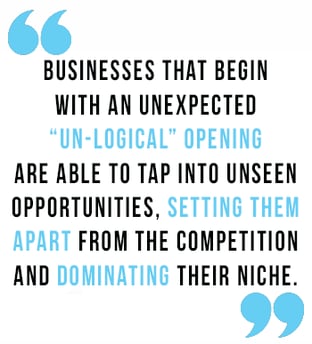
Companies that begin with an unexpected “un-logical” opening are able to tap into unseen opportunities, setting them apart from the competition and dominating their niche.
There is plenty of solid data to back up this observation. Over the past 15 years I have studied the corporate strategies of around 400 large and mid-sized companies to extract common lessons for unlocking business growth. I’ve also completed a two-year study with the 100 most competitive companies of the last decade.
From my research, I found several distinct strategic openings that create an early advantage to outwit the competition. Companies who apply any of these seven strategic openings go on to produce a lasting period of dominant growth, profitability and value creation.
- #1 Ally with a partner outside your market
- #2 Move early to the next battleground
- #3 Lock up resources
- #4 Attack from two fronts
- #5 Introduce a new piece to the game board
- #6 Coordinate the uncoordinated
- #7 Embrace what others abandon
In this article, I will go into these strategies in more detail. We’ll look at how some of the world’s best known and most successful companies emerged from these approaches.
Let’s dive in.
 #1 Ally with a partner outside your market
#1 Ally with a partner outside your market
When you partner with a player outside your market, you can catch your competition off guard. Of the 100 companies I studied, 21% cited using this move.
One of them was the largest motorcycle company in the world: India’s Hero Honda.
 Although Hero Honda produces more than 3 million bikes a year, they remain relatively unknown in the Western world. Thus, many don’t know of how their success stems from an ally between two distant enemies: a motor company and a bicycle distributor.
Although Hero Honda produces more than 3 million bikes a year, they remain relatively unknown in the Western world. Thus, many don’t know of how their success stems from an ally between two distant enemies: a motor company and a bicycle distributor.
First, a little bit of a backstory.
India’s government has protective laws that don’t allow foreign companies to enter the country unless they create a minority joint venture with a local company. So, when Honda wanted to sell its motorcycles in India, they needed to find a local partner.
Logically, Honda should partner with a company that has experience assembling and distributing motorcycles.
Instead, they chose to align with a family-owned bicycle firm: Hero.
Founded by two brothers in the 1950s, Hero was one of India’s leading bicycle brands who had:
- Begun adopting just-in-time inventory practices pioneered by Honda and other Japanese manufacturers.
- Blanketed India with a large network of independent bicycle dealers.
- Organized hundreds of suppliers who delivered just in time.
These 3 factors convinced Honda to partner with Hero. This caught the competition off guard. While their competition was busy focused on running their own dealerships at limited locations, Honda leveraged Hero’s independent dealers to establish a powerful network of 5,000 outlets.
Had Honda partnered with a “nearby” enemy, it might have remained in a crowded pack of good motorcycle companies. Instead, by partnering with a distant enemy, Honda became outstanding at its game and established its dominance over competitors like Suzuki, Yamaha and Kawasaki.

#2 Move early to the next battleground
This next strategy leverages an increasing pace of disruption. New battlegrounds in business are emerging at an accelerated pace. If you can identify when and how your market will evolve, you can move to the next battleground and establish a defensive position before your competition even realizes that the future has changed.
Of the companies I studied, 21% cited using this move, including many of the world’s most dominant companies (like Walmart and Google). Let’s first take a look into how Google executed this strategic opening.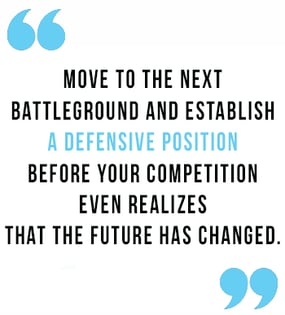 Early on in the game, Google realized that internet users would increasingly start their surfing sessions through a search engine. They realized that instead of typing an address into their browser’s URL box, users would prefer to enter search terms into their favorite search engine.
Early on in the game, Google realized that internet users would increasingly start their surfing sessions through a search engine. They realized that instead of typing an address into their browser’s URL box, users would prefer to enter search terms into their favorite search engine.
Google moved onto this battlefield early on in the game and positioned themselves to play defense instead of offense. Despite costly efforts to improve their search engines, both MSN and Yahoo! continue losing ground to Google. It has effectively turned the game on its main competitors.
As for Walmart, their success also sprung from a simple initial tactic: identifying the next battleground, setting up a stronghold there, and waiting for the competition. While large retailers such as Sears, JC Penny, and Kmart positioned stores only in large city and town centers, Walmart took the opposite approach: it focused on smaller towns.
Walmart adopted this strategy in part to avoid direct competition, and in part because they believed the battleground would shift. They predicted that as consumers began migrating to suburban neighborhoods, consumers would subsequently prefer to shop at suburban retail stores over city-center retail stores.
When leading retailers faced with declining sales in their key locations followed customers into these smaller markets, they encountered an unexpectedly strong competitor. Walmart had been waiting for them, fortified with a strong brand and an efficient distribution system. Today, Walmart has become the world’s largest retailer thanks to their strategic opening move of moving early to the next battleground.

#3 Lock up resources
This next strategic opening is much like a strike from the shadows. It starts with identifying critical pinch points in supply in your niche or industry. By doing so, you can restrict your competitors’ access to resources, thereby preempting their ability to resist your expansion.
17% of the companies I studied used this move. Take the case of the iPod. While a sequence of creative decisions contributed to iPod’s success, Apple would have fallen at the starting gates were it not for this strategic opening of locking up resources. When Apple launched its first iPod, it signed an exclusive agreement with Toshiba which prevented competitors from following quickly. The iPod is essentially built of two key components: a hard-drive and a beautiful box. Before the iPod, hard drives were simply too large to fit in an appealing box. Toshiba had recently developed a revolutionary new hard drive the same size as players that use flash-memory the size of flash-memory-based players, but could hold ten times the number of songs as these flash-memory players.
The iPod is essentially built of two key components: a hard-drive and a beautiful box. Before the iPod, hard drives were simply too large to fit in an appealing box. Toshiba had recently developed a revolutionary new hard drive the same size as players that use flash-memory the size of flash-memory-based players, but could hold ten times the number of songs as these flash-memory players.
Apple quickly made its move: it purchased Toshiba’s entire inventory of these new hard drives to prevent competitors like Sony from following too closely. By locking up Toshiba’s supply, at least temporarily, Apple made it impossible for competitors to match the iPod’s performance.
This gave Apple a period of protection of several months, which, in the consumer-electronics market, can make a world of difference. By the time competitors could get their hands on Toshiba’s new hard drives, iPod had imprinted itself in the minds of consumers.
Many other companies have sustained strong profits by applying this move. Coca-Cola, for instance, signed large, long-term supply contracts with corn syrup manufacturers. This effectively blocked Pepsi from their supply of corn syrup. Oil and gas companies compete primarily by locking up drilling rights. De Beers came to dominate the diamond industry by locking up mines.
But perhaps the most interesting application of this tactic involved Minnetonka, the maker of Softsoap. Before Procter & Gamble and Colgate-Palmolive introduced their own liquid-soap products, Minnetonka signed large, long-term contracts with the manufacturers of the pumps needed to produce liquid-soap products.
This strategy afforded Minnetonka sufficient time to establish a defensible position in liquid soaps. While most small companies that go head to head with P&G and Colgate-Palmolive fail, Minnetonka survived by targeting its enemy’s source of power, rather than attacking directly.

#4 Attack from two fronts
Many successful companies are now creating a name for themselves in more than one industry. We call this strategic dynamic the “two-front battle”, and 16% of the companies I studied cited using this move.
Amazon is one of them. In the early 2000s, Amazon was generating nearly all of its revenue from online sales and was considered an e-commerce company from an external perspective. To others, it wouldn’t be logical for Amazon to help other retailers with technology support to bolster their own e-commerce businesses. After all, this would be helping their competitors. 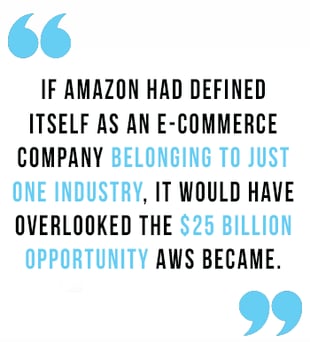
Yet, that’s exactly what Amazon was doing. They were helping retailers like Target manage their e-commerce technology. There were doing this because Amazon viewed itself and its business differently. Jeff Bezos once said, “we are in the business of protecting customers’ information”.
Their vision was “to be Earth’s most customer-centric company.”
None of these statements anchor Amazon in e-commerce. So, the idea of helping retailers with their technology made sense to them. They developed a cloud service called Amazon Web Services (AWS) which proved popular among retailers and other businesses. By 2018, AWS was generating over $25 billion in revenue.
If Amazon had defined itself as an e-commerce company belonging to just one industry, it would have overlooked the $25 billion opportunity AWS became. Another important thing to note is that a large part of AWS’ success comes from the fact that Amazon forced their competitors onto a two-front battle, which their competitors were not prepared for.
Software firms like Microsoft had already identified the cloud service market as a big opportunity. Microsoft was prepared to compete with other software firms like Oracle, but had not considered a retailer like Amazon to be a credible player in the space. Essentially, Microsoft now had to compete on two fronts: one against software companies and another against Amazon.

The siege of British Airways by Virgin is another example of this strategic opening. By 1984, numerous start-up airlines had failed to challenge British Airways in the U.K. When Virgin Group launched Virgin Atlantic, it had less money, capacity, political clout, and experience.
However, Virgin had something other direct competitors of British Airways didn’t have: a strong brand in the music industry. Virgin leveraged its music brand to win over airline passengers with edgy advertisements and PR stunts. British Airways was under attack on two fronts — airlines and music.
In just five years Virgin Atlantic grew to £10 million in profits. Today, it generates over £2.5 billion in revenue and is the first UK-born airline to have successfully competed against British Airways.

#5 Introduce a new piece to the game board
By creating a new entity, you can disrupt competitive dynamics in your favor. Of the companies I studied, 13% grew by applying this move.
One of the most intriguing case studies of this move is Igvar Kamprad, a furniture salesman with a simple business. Kamprad would rent space at furniture conferences and sell furniture. He was such a successful salesman that his competitors ganged up on him and prevented him from participating. Kamprad could have decided to sell something else or find a different furniture conference, but instead he decided to create something out of nothing. 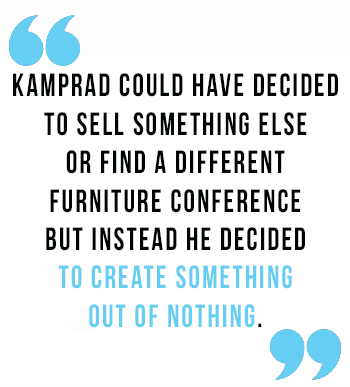
Kamprad created his own furniture conference but didn’t allow his competitors to sell their goods at his conference. His new furniture conference business made so much profit, he decided to run another conference and then another. Eventually, it occurred to him that he might as well run his conference every day. That concept became what is now IKEA, the largest furniture retailer in the world. By creating something out of nothing, Kamprad disrupted his industry.
Another application of this tactic is creating your own customer. This is what Tony Fernandes did when he bought the nearly bankrupt airline AirAsia for just 27 cents in 2001. Fernandes’ core concept was not to compete for airline customers. Instead, he created new airline customers by convincing railroad customers to take a plane instead.
He opened up routes in smaller airports, closer to geographies in which people tended to take railroads. He geared his marketing and pricing to appeal to railroad customers. By creating a new customer, he unlocked a new, uncontested market space. Today, Air Asia is the second-largest discount airline in the world.
This move can also be applied through creating a new category. Gatorade, for example, started off selling drinks with electrolytes designed to replenish tired athletes. They didn’t sell their drink in stores, they sold it to athletic clubs.
As Gatorade’s sales grew, Pepsi and Coca-Cola failed to notice because their market share reports did not (yet) include the new sports-drink category Gatorade was creating. By the time they realized there was a new category, it was too late. Gatorade had solidified its position and remains the largest sport-drink brand up to this day.
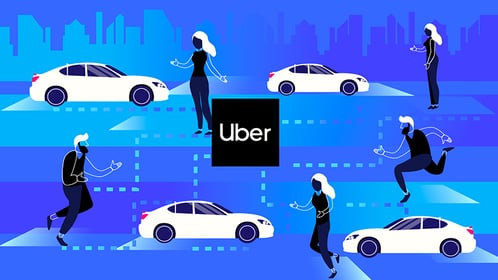
#6 Coordinate the uncoordinated
If you can organize independent players into a coordinated front, you can simulate greater power with less investment. 13% of the companies I analyzed applied this move. Wikipedia and open source software are great examples of this principle at work.
In 2001, an unusual player entered the encyclopedia market. Jimmy Wales and Larry Sanger had been working for Nupedia, a web-based encyclopedia that provided free content reviewed and edited by experts. Nupedia’s innovation was delivering content exclusively via the web, not by CD-ROM or print, and it gave its content away for free.
Then, Nupedia added a new service: an open encyclopedia that users could edit without the burden of expert review. This had the potential to unlock an ocean of content. Contributors spontaneously organized to build content and by the end of its first year, the new service called Wikipedia had grown to approximately 20,000 articles in 18 languages. By the end of 2006, Wikipedia had absorbed its former parent Nupedia and became a stand-alone business wielding an army of over 4,500 active editors who offer over 5 million articles in 229 languages. 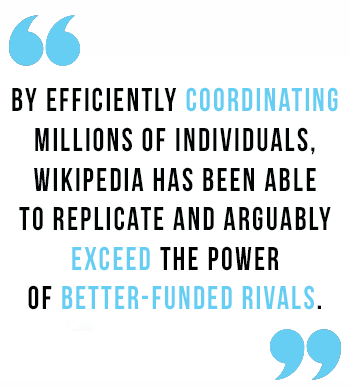
Its English-language edition alone offers over 1.4 million articles, dwarfing its competitors Britannica and Microsoft’s Encarta that had about 100,000 and 68,000 articles respectively. By efficiently coordinating millions of individuals, Wikipedia has been able to replicate and arguably exceed the power of better-funded rivals.
This pattern of coordinating individual elements is growing in prevalence. Uber has used it to disrupt the automobile market by coordinating under-used automobile capacity. Airbnb has grown into a company worth over $30 billion in less than ten years by coordinating under-used bedrooms, apartments, and houses.
Today, we are on the cusp of an historic breakthrough in the application of this strategic approach with Blockchain technology, which enables the coordination of information without any central authority maintaining the official record. Used primarily to enable cryptocurrencies, blockchain is finding its way into other applications such as music.
Historically, musicians depended on music labels to track when their songs are played to calculate royalty payments. With blockchain, no central authority is needed, opening up a whole new possibility in the industry.
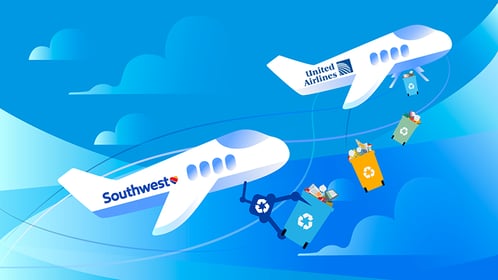
#7 Embrace what others abandon
Many of the most disruptive companies in history were not born out of doing something new but from embracing something old. By adopting what your market discards or abandons — such as an old business model, a technology, or player — you can secure an advantage because your competitors are unlikely to “return to the past” after moving on to something new.
This strategy works particularly well when competitors, in their drive for “innovation,” clamor for the new thing. Another 13% of the companies I analyzed used this move to some degree.
Southwest Airlines is a prime example of finding a jewel among the discarded by resuscitating an abandoned business model.
The largest airlines had long-since switched to the hub-and-spoke system. The hub is a central airport that flights are routed through, and spokes are the routes that planes take out of the hub airport. The hub-and-spoke system allow airlines to offer more flights for passengers and book full planes more consistently. 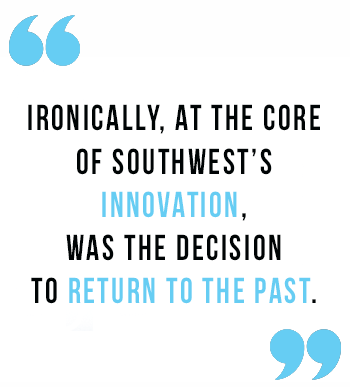 Southwest Airlines however decided to put their gear in reverse. They shook up the industry by reintroducing the old point-to-point model. This old system takes travelers directly to a destination, instead of going through a central hub. Adopting this model helped Southwest to differentiate its business by offering the convenience of point-to-point travel which other airlines were not offering. It was also difficult for its competitors to copy, because they had invested heavily in hubs.
Southwest Airlines however decided to put their gear in reverse. They shook up the industry by reintroducing the old point-to-point model. This old system takes travelers directly to a destination, instead of going through a central hub. Adopting this model helped Southwest to differentiate its business by offering the convenience of point-to-point travel which other airlines were not offering. It was also difficult for its competitors to copy, because they had invested heavily in hubs.
As a result, Southwest enjoyed a long period of differentiation. Ironically, at the core of Southwest’s innovation, was the decision to return to the past. Another company that succeeded with this strategy was Craigslist.
At a time when websites were investing in video and dynamic displays, Craigslist embraced the abandoned. They created what most interface designers would call an ugly interface of simple text links. This choice helped Craigslist emerge as the most popular online classified site in the US and disrupt the newspaper industry.
Out-of-the-Box Strategies Create Extraordinary Success
From the case studies covered in this article, we can see how these seven out-of-the-box opening strategies can put businesses on the path of differentiation, innovation and extraordinary success. In total, I identified 36 strategic differentiators that give you the competitive edge in your market.
If you want to create innovations and stand out from the competition, I invite you to apply one of these seven strategic openings from the playbook of innovative disruptors.
These openings will require you to let go of traditional strategy methods and, at least temporarily, abandon the apparent comfort of logic. The pay off? You’ll set yourself up to create new market openings and drive innovation from the start.



